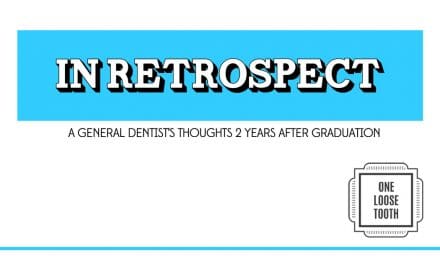As we get closer to graduation, many young doctors will begin seeking employment. This post is intended to help those looking for their first job. If you have any tips for the new grad please leave them in the comments.
It’s really difficult to bring an associate into what most dental students describe as a private practice (the traditional solo doctor practice).
First, dentists spend a long time building their practices and small business ownership is often just as painful as it is rewarding. Developing relationships with your patients is a delicate process and trust is much easier to lose than it is to gain.
Second, dentists’ incomes are declining and there does not appear to be a catalysts on the horizon that will reverse this trend in the near term. The reason for the decline in income is that overhead continues to rise, and more patients have obtained and want to use their “dental insurance†– making out of network growth more difficult than it used to be. The challenge with growing an insurance based practice to support an associate is that reimbursement is seldom raised and is typically stagnant and can even be readjusted to a lower fee schedule. This means that the private practice dentist just can’t afford to share any of her current patients with another dentist unless the owner is willing to see a decline in her own income (at least over the short term).
Third, and last, most private offices were built for one doctor and 1-2 hygienists and only have 3-4 operatories. Without a physical expansion or extending the hours (this requires addition staff), these practices don’t have the capacity to add a second full-time dentist.
With that said, new dentists should understand why a more senior dentist will likely be reluctant to employ them.
New graduates should also know that bringing in an associate, especially a new graduate, isn’t for everyone. Those that have great opportunities won’t want to bring in a stranger or a new grad and then see them leave in 1-3 years. If the associate wasn’t great (it can take a year or two to really find out) the owner can be stuck picking up the pieces for years after the associate’s departure.
With this in mind, it’s unlikely that a private-practice owner would want to advertise an opening for an associate (or hire one they met on Craigslist). Instead, they’ll tell a friend, who tells a friend, who tells you, and a meeting is arranged. If it goes well, you’ll meet again. Then again. Then you’ll stay in touch. And maybe you’ll be asked to associate in the practice if a need comes up.
So where do new graduates find an associate position? Or how should they go about finding a job?
If you’re attending a dental school or residency close to where you would like to live and work, try to attend events where you may have an opportunity to meet local dentists. This might be through your state or local dental association, or the Academy of General Dentistry, or another organization. Meet dentists, be kind and curious, and make a habit of staying in touch. As you prepare to graduate, reach out to those dentists you talk to frequently and ask if they know of anyone looking for an associate.
Sometimes, something lines up, but don’t be discouraged if these relationships furnish no leads.
If your personal network is no help, you’ll need to pursue alternative avenues – this includes some online databases such as job search engines like Indeed, and classified ads published on Dental Town, Craigslist, and your local dental society’s website or newsletter.
Don’t be afraid to publish your own information on Dental Town and your local dental society’s website if they have a “for hire†section.
From there, reach out to people who work within the dental industry and interact with dentists in your area. This includes dental labs, practice brokers, dental specific attorneys, dental CPAs, and supply reps. These individuals are often conversing with a lot of dentists at any given time and will likely know who needs help and is busy enough to support an associate.
You can also send letters. Using Google Maps and a few hours of your time, you can obtain the name and address of most dentists in a geographic area. Collect the information and mail a letter introducing yourself as a potential associate (include a picture or link to your LinkedIn profile). If you don’t have time to gather this data on your own, use Fiverr or Mechanical Turk to hire someone to collect the data for you.
If you lack experience, but present well in-person, you can select a few offices that you think would be a good fit and deliver a packet to the front office staff in person. Don’t ask to speak to the dentist, just walk in, say hello to the front office staff, leave your resume and leave. If you left a good impression the front office may tell the dentist to call you.
Throughout this processes, realize that the young dentist is in difficult position because you can’t get a job without experience, and you can’t gain experience without the job.
This brings me to Practice Rail – a new website I’m building to help young dentists find employment or ownership opportunities. Dentists often practice alone, and if we do not practice in close proximity to a dental school or residency program, we have difficulty meeting and finding potential associates or partners. If you’re a new graduate, resident, or dental student who is looking for employment in a private practice, I’m building a database to help connect you to owners who are looking for help.
You can add yourself to our database by filling out the form here: https://practicerail.com/associate-placement/





Trackbacks/Pingbacks